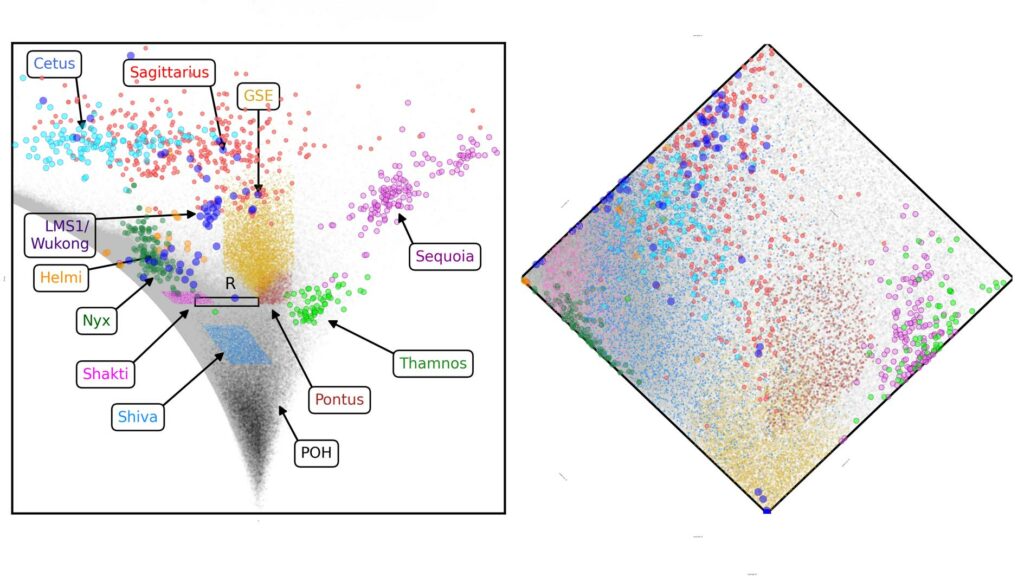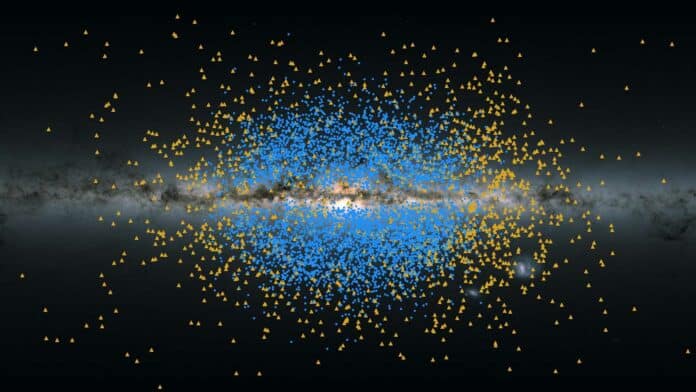ESA‘s Gaia space telescope has identified two surprising streams of stars that formed and fused together more than 12 billion years ago, providing new insights into the history of our galaxy.
These two streams, known as Shakti and Shiva, were instrumental in forming the early Milky Way. They form even before the oldest parts of the galaxy’s disk and spiral arms start to take shape, making them incredibly ancient.
Khyati Malhan of the Max Planck Institute for Astronomy (MPIA) in Heidelberg, Germany, who led the research, said, “What’s truly amazing is that we can detect these ancient structures at all. The Milky Way has changed so significantly since these stars were born that we wouldn’t expect to recognize them so clearly as a group – but the unprecedented data we’re getting from Gaia made it possible.”
The team used Gaia observations to determine the orbits of individual stars in the Milky Way, along with their content and composition. When they visualized the orbits of these stars, they found two new structures that stood out from the rest among stars of a certain chemical composition.
Each of the two streams, Shiva and Shakti, contains a mass of around ten million Suns. They are made up of stars 12–13 billion years old, all with similar compositions and orbits. Given their dispersal, it’s possible that they started out as separate pieces that joined the Milky Way in the early phases of its development.

Nestled in the center of the Milky Way, Gaia’s “galactic archaeology” project included an exploration of both streams in 2022. The oldest known stars are abundant in this part of the galaxy; they were all born before the Milky Way’s disk was fully formed.
Co-author Hans-Walter Rix, also of MPIA and the lead ‘galactic archaeologist’ from the 2022 work, said, “The stars there are so ancient that they lack many of the heavier metal elements created later in the Universe’s lifetime. These heavy metals are those forged within stars and scattered through space when they die. The stars in our galaxy’s heart are metal-poor, so we dubbed this region the Milky Way’s ‘poor old heart’.”
“Until now, we had only recognized these very early fragments that came together to form the Milky Way’s, ancient heart. With Shakti and Shiva, we now see the first pieces that seem comparably old but located further out. These signify the first steps of our galaxy’s growth towards its present size.”
The two streams, Shiva and Shakti, are similar but distinct. Shiva stars orbit closer to the Milky Way’s center than Shakti stars, with more circular orbits. Their names are derived from a Hindu philosophical pair of deities credited with creating the universe.
The Milky Way’s current spiral shape is significantly different from what it looked like around 12 billion years ago. It most likely originated from several irregular, lengthy strands of gas and dust that combined to form stars and eventually shaped our galaxy. Shiva and Shakti are thought to be the remains of these threads. Further Gaia data releases could reveal more of these parts.
Timo Prusti, Project Scientist for Gaia at ESA, said, “Revealing more about our galaxy’s infancy is one of Gaia’s goals, and it’s certainly achieving it. We need to pinpoint the subtle yet crucial differences between stars in the Milky Way to understand how our galaxy formed and evolved. This requires incredibly precise data – and now, thanks to Gaia, we have that data. As we discover surprise parts of our galaxy like the Shiva and Shakti streams, we’re filling the gaps and painting a fuller picture of not only our current home but our earliest cosmic history.”
Journal Reference:
- K. Malhan and H.-W. Rix. ‘Shiva and Shakti: Presumed Proto-Galactic Fragments in the Inner Milky Way’. The Astrophysical Journal. DOI: 10.3847/1538-4357/ad1885
